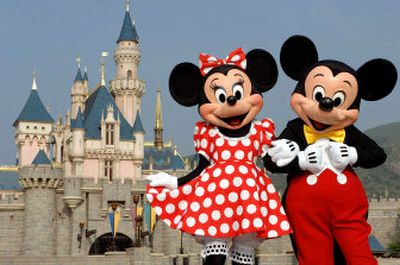Mickey goes to Hong Kong

HONG KONG – Mickey Mouse, Sleeping Beauty’s castle and the Lion King are all here at Disney’s new theme park in Hong Kong, along with classic rides familiar to fans of other Disney theme parks: Space Mountain, the Mad Hatter Tea Cups and Dumbo.
But in creating the Disney experience for a mostly Chinese audience, this thoroughly American – and notoriously detail-obsessed – company has incorporated many elements of local culture.
Experts in the Chinese tradition of feng shui – the belief that harmonious energy and good fortune can be achieved by the correct positioning of furniture and other objects – were put on the payroll.
And while Coke and hamburgers can easily be found, guests can also dine on dim sum and sweet-and-sour pork. Signage is in both Chinese and English.
On the advice of feng shui masters, the park faces the water with mountains in the back. The feng shui experts even picked the opening date of the park, Sept. 12.
Park officials also tweaked the layout to conform with feng shui principles. They recommended “no fire” zones in restaurant kitchens – with an eye to keeping the five elements of metal, water, wood, fire and earth in balance – and water fountains.
A giant fountain near the park entrance features Mickey Mouse surfing on a stream of water spouting from a whale. Statues of Donald Duck and Minnie Mouse stand nearby.
Visitors can navigate the park with signs written in their native Chinese, but the rides also include bilingual explanations. Inside the Buzz Lightyear Astro Blasters ride, a talking animated Buzz Lightyear figure speaks in English while Chinese subtitles are flashed on a display board nearby.
Disney has delved deepest into local culture with the menu, which encompasses several Asian cuisines. Apart from Chinese staples, there’s also Kashmiri chicken curry and shrimp and vegetable tempura.
The Asian culinary delights are served in restaurants with decidedly un-Chinese architecture, providing a sometimes bizarre East-meets-West contrast.
The Tahitian Terrace restaurant serves roasted duck and curry laksa noodle soup. The Viennese-influenced Market House Bakery in Main Street, U.S.A, uses European decor but juxtaposes Western pastries with Hong Kong-style delicacies. Chocolate croissants and cinnamon rolls are displayed alongside barbecued pork puffs, egg tarts and pineapple buns.
The rest of the park is vintage Disney. Hong Kong’s subway operator has launched a Mickey-themed train carriage – with windows and hanging straps shaped like the character’s head – to ferry visitors from a suburban rail line to the park and back.
Hong Kong Disneyland also includes a variety of Disney attractions found elsewhere. There is a Jungle River Cruise and the “Festival of the Lion King” show, inspired by the animated movie.
Anchoring the park’s skyline is a replica of the original Sleeping Beauty Castle from Disneyland in Anaheim, Calif., the flagship park that opened 50 years ago.
And “The Golden Mickeys,” a Broadway-style show that until now has been seen only on Disney cruises, has come ashore with its debut in Hong Kong.
One standout in Hong Kong is Mickey’s PhilharMagic in Fantasyland, a 3-D show with appearances from Mickey, Donald Duck, Ariel from “The Little Mermaid,” Aladdin, Peter Pan, Tinker Bell and Simba.
With the help of 3-D glasses, the Disney characters appear as if they’re right in front of the viewer. When Donald Duck is splashed with water, the audience is likewise sprinkled. The scent of cherries fills the theater when a dessert dish shows up on screen.
Mickey Mouse, Donald Duck and Goofy certainly aren’t alien to the children of Westernized Hong Kong, but the average person in mainland China, a major target market for Hong Kong Disneyland, is less Disney-savvy.
So Disney has launched a massive marketing campaign. It tapped clean-cut Hong Kong pop star Jacky Cheung – a singer and actor who is one of the biggest acts in the Chinese-speaking world – as park spokesman.
Since July 2004, Chan has hosted a TV program aired in both Hong Kong and China that shows classic Disney movies.
At 310 acres, Hong Kong Disneyland is the smallest Disney park in the world, but Disney says expansions are planned. One addition already lined up is the Autopia car ride in Tomorrowland.
Pricing at the park is affordable by Hong Kong standards but on the higher end for visitors from China. Even in the commercial hub of Shanghai, which enjoys a much higher standard of living than most Chinese cities, the minimum monthly wage is a paltry $85.
At the Emporium souvenir shop, a Mickey Mouse key chain costs $7.70; a standard Hong Kong Disneyland cap is priced $13.
Admission is $45 for the weekend and public holidays, $38 on weekdays – the cheapest among Disney’s five parks around the world. Children under 11 pay $32 on weekends and $27 during the week.
The park houses two hotels: Victorian-style Hong Kong Disneyland Hotel, with lots of towers and fussy architecture, and the sleek-looking Disney’s Hollywood Hotel.
These accommodations are steeply priced: Hong Kong Disneyland Hotel starts at $205 a night and Disney’s Hollywood Hotel’s cheapest room costs $128.
For budget travelers, staying in the city is recommended. Hong Kong offers hotels in many different price ranges, and the park is only about a 20-plus minute subway train ride from downtown Hong Kong.